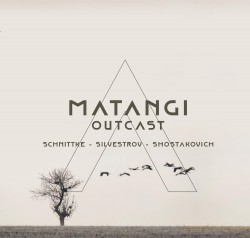 Just as Terry Robbins’ column is named “Strings Attached,” this month mine could be called “Strings Galore.” First up is Matangi: Outcast – Schnittke | Silvestrov | Shostakovich (Matangi Music MTM04 matangi.nl), an album devoted to “musical troublemakers and outsiders, three Soviet-Russian composers who wrote music that went dangerously against the tastes of the regime under which they lived.”
Just as Terry Robbins’ column is named “Strings Attached,” this month mine could be called “Strings Galore.” First up is Matangi: Outcast – Schnittke | Silvestrov | Shostakovich (Matangi Music MTM04 matangi.nl), an album devoted to “musical troublemakers and outsiders, three Soviet-Russian composers who wrote music that went dangerously against the tastes of the regime under which they lived.”
The Matangi string quartet has been at the forefront of contemporary music in the Netherlands since its founding at the turn of the current century. In their own annual (Un)heard Music Festival in The Hague they present works that are rarely if ever heard in Dutch concert venues, venturing beyond the realm of traditional concert music to include jazz, dance and pop while still embracing the classical canon. A recent guest at the festival was the reclusive Ukrainian composer Valentin Silvestrov (b.1937), a polystylist whose early works ranged from serialist to pointillist, resulting in him being branded avant-garde and refused entry to the Union of Soviet Composers. He has said of his early contrarian works “composing radical music was like working with a mountain of salt that you used up completely. Now I take a handful of salt, just for the taste.” Silvestrov’s delicate, indeed at times barely audible, 1974 extended one-movement String Quartet No.1 provides a gentle bridge between the more familiar works by Schnittke and Shostakovich on this disc, which opens with the former’s String Quartet No.3. Schnittke was also influenced by a plethora of styles, often rooted in Western culture, and likewise deemed unacceptable by the Soviet powers that be. He often incorporated what he called “forgeries” of other compositions and his quartet opens with quotes from Orlando di Lasso, Beethoven and Shostakovich which reappear throughout the quartet. Of particular note is the Agitato second movement that layers a ghostly hint of Lasso’s Stabat Mater into an angular waltz often interrupted by strident echoes of Shostakovich’s eighth string quartet. It is this latter work that concludes the disc. The Quartet in C Minor, Op.110 was sketched in three days in 1960 in Dresden where the composer was deeply affected by the ruins left by the Allies’ firebombing of the city during the late days of the Second World War. It is one of Shostakovich’s darkest works, opening with a Largo movement although, as mentioned, it also has strident moments in the Allegro molto second, and features a lilting waltz third movement, before returning to the glacial pace of the first in the final two Largo movements. The Matangi give outstanding performances of all three works on this particularly timely release.
Listen to 'Outcast' Now in the Listening Room
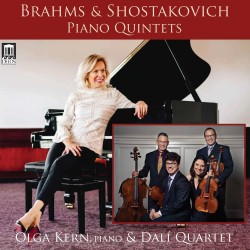 Russian/American pianist Olga Kern is featured with the Dalí Quartet on Brahms & Shostakovich Piano Quintets (Delos DE 3587 delosmusic.com). In an impassioned statement accompanying the release Moscow-born Kern, whose grandfather was Ukrainian and great-grandmother an opera singer in Kharkiv, says “I defy war. It’s heartbreaking to witness the tragedy that is unfolding before our very eyes in Ukraine. It’s ugly and brutal beyond words and it also brings us together in the face of injustice. […] Please stop this madness! Please say NO to war!”
Russian/American pianist Olga Kern is featured with the Dalí Quartet on Brahms & Shostakovich Piano Quintets (Delos DE 3587 delosmusic.com). In an impassioned statement accompanying the release Moscow-born Kern, whose grandfather was Ukrainian and great-grandmother an opera singer in Kharkiv, says “I defy war. It’s heartbreaking to witness the tragedy that is unfolding before our very eyes in Ukraine. It’s ugly and brutal beyond words and it also brings us together in the face of injustice. […] Please stop this madness! Please say NO to war!”
Unlike the later string quartet discussed above, Shostakovich’s Piano Quintet in G Minor, Op.57, is a sunny work. It was composed in 1940, before Hitler’s invasion of the Soviet Union, “a time of deceptive optimism among the Russian people [when] even the despair-prone Shostakovich was hopeful that he could maintain his [newfound] status as [a] favoured composer.” This work did indeed prove popular with the public and even won Shostakovich the inaugural Stalin Prize. In homage to Bach, the quintet opens with a Prelude introduced by the piano, followed by a second movement Fugue in which the strings intertwine until about the two-minute mark when the piano joins in. The contemplative spirit of the opening movements is interrupted by a truly joyous, ebullient Scherzo lasting a brief three minutes. A languorous Intermezzo follows before a playful and melodious Finale brings this beloved half-hour work to an end.
It seems to have been Robert Schumann who first combined solo piano with string quartet, giving birth to the genre of piano quintet in 1842. Some 20 years later Brahms, by then a familiar member of the Schumann household, composed his own Piano Quintet in F Minor but in this instance opting for two cellos. The work was not well received and he went on to make a two-piano version that was equally unsuccessful before finally settling on the more usual arrangement of piano, two violins, viola and cello, which became the lush and lyrical work we now know as Op.34.
Known for its championing of Latin American repertoire – the quartet members hail from Venezuela, Puerto Rico and the United States and the group received the Atlanta Symphony’s Aspire Award for accomplished African American and Latino musicians – the Dalí Quartet shows itself here to be just as thoroughly at home with European repertoire in these sparkling performances. Kern, among whose awards is a Gold Medal from the Van Cliburn International Piano Competition, shines throughout.
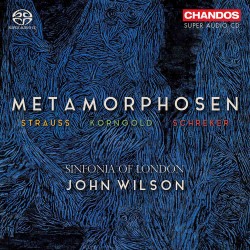 Speaking of lush, a work Glenn Gould once called “the most moving piece of the 20th century” gives the title to the next disc: Metamorphosen – Strauss | Korngold | Schreker featuring Sinfonia of London under John Wilson (Chandos CHSA 5292 naxosdirect.com/search/chsa5292). Of course Gould also referred to Metamorphosen as “23 wayward strings in search of a cadence” or some such pithy phrase, but he does seem to have had great admiration for Richard Strauss’ 1945 study for 23 solo strings. Wilson leads his ensemble flawlessly through the meandering journey which lasts 28 minutes, negotiating the waves of sturm und drang – at times reminiscent of Schoenberg’s Transfigured Night – without ever losing the thread or floundering into troubled waters. It’s a truly transcendent voyage.
Speaking of lush, a work Glenn Gould once called “the most moving piece of the 20th century” gives the title to the next disc: Metamorphosen – Strauss | Korngold | Schreker featuring Sinfonia of London under John Wilson (Chandos CHSA 5292 naxosdirect.com/search/chsa5292). Of course Gould also referred to Metamorphosen as “23 wayward strings in search of a cadence” or some such pithy phrase, but he does seem to have had great admiration for Richard Strauss’ 1945 study for 23 solo strings. Wilson leads his ensemble flawlessly through the meandering journey which lasts 28 minutes, negotiating the waves of sturm und drang – at times reminiscent of Schoenberg’s Transfigured Night – without ever losing the thread or floundering into troubled waters. It’s a truly transcendent voyage.
Hans Schreker’s brief and lyrical Intermezzo, Op.8 from 1900 lightens the mood and sets the stage for Erich Wolfgang Korngold’s Symphonic Serenade for String Orchestra Op.39 (1947-48). If we thought that the 23 strings of the Strauss were sufficient, Korngold disagreed. He scored his serenade for 16 each of first and second violins, 12 violas, 12 cellos and 8 double basses. Somehow Wilson manages to keep these 64 string instruments from turning into an indecipherable wash of sound, even in the densest passages. The sprightly pizzicato second movement provides welcome contrast to the lyrical opening and the languorous third, but it is the hold-on-to-your hats rollercoaster finale that is the icing on the cake; a flourishing finish to a thoroughly satisfying disc.
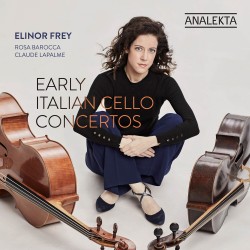 After immersing myself in the dense, lush – I keep wanting to say “at times lugubrious,” but that’s not right, they are simply thick, rich and gorgeous – textures of Brahms and Strauss, I found I needed a palette cleanser. A new Analekta release, Early Italian Cello Concertos featuring Elinor Frey and Rosa Barocca under Claude Lapalme (AN2 9163 analekta.com/en), proved just the thing. In her extensive and informative booklet notes Frey discusses the development of the violoncello, describing it as actually a family of instruments originating with the violone, a small type of bass violin current in the 17th century. “Only beginning in the 1720s did a sort of ideal compromise instrument, of a size halfway between the smallish Baroque violoncello and the larger violone, establish itself as our current standard cello. The term violoncello piccolo, often used today to denote the typical Baroque violoncello, is in part a modern invention – an anachronistic misnomer […which] only makes sense when used in comparison with our larger modern instrument.” She also discusses the differences between four- and five-string versions of the cello.
After immersing myself in the dense, lush – I keep wanting to say “at times lugubrious,” but that’s not right, they are simply thick, rich and gorgeous – textures of Brahms and Strauss, I found I needed a palette cleanser. A new Analekta release, Early Italian Cello Concertos featuring Elinor Frey and Rosa Barocca under Claude Lapalme (AN2 9163 analekta.com/en), proved just the thing. In her extensive and informative booklet notes Frey discusses the development of the violoncello, describing it as actually a family of instruments originating with the violone, a small type of bass violin current in the 17th century. “Only beginning in the 1720s did a sort of ideal compromise instrument, of a size halfway between the smallish Baroque violoncello and the larger violone, establish itself as our current standard cello. The term violoncello piccolo, often used today to denote the typical Baroque violoncello, is in part a modern invention – an anachronistic misnomer […which] only makes sense when used in comparison with our larger modern instrument.” She also discusses the differences between four- and five-string versions of the cello.
For this recording – which includes works by Sammartini (1700-1775), Vivaldi (1678-1741), Tartini (1692-1770) and Leonardo Leo (1694-1744) – Frey uses two different instruments, the smaller Baroque size in the Sammartini and Tartini, and the modern size for Vivaldi and Leo. These latter she says “have inspired quite a few modern-day cellists to perform on a five-string instrument, in part because of the fiendishly difficult passagework that ascends into the upper register. […] Over time I came to view these works as demanding and thrillingly virtuosic concertos that belonged to the larger four-string cello repertoire.” Thrilling virtuosity is especially true of Leo’s Concerto No.2 in D Major, which I first encountered in Anner Bylsma’s recording with Tafelmusik back in my days at CJRT-FM; it became a favourite and I programmed it frequently, both on Music Before 1800 with Peter Keigh and during regular morning broadcasts with Alex Baran. As seminal as that recording was in my developing an interest in Baroque music, I must say that Frey and Rosa Barocca, a Montreal ensemble of which I was not previously aware, surpass this forerunner in terms of crispness, energy and articulation. From start to finish this disc is enthralling; my only quibble is the choice to end the recital with a minor key Andante cantabile movement from a violin sonata by Tartini, one of two Frey transcriptions to grace the disc. I would have preferred it to end with a bang, not a whimper, lovely though it is.
Listen to 'Early Italian Cello Concertos' Now in the Listening Room
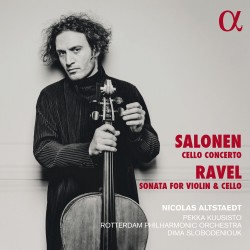 Palette cleansed, I returned to our current century with Nicolas Altstaedt’s performance of Esa-Pekka Salonen’s Cello Concerto with the Rotterdam Philharmonic Orchestra under Dima Slobodeniouk (Alpha ALPHA627 naxosdirect.com/search/alpha627). This riveting 2017 work was co-commissioned by the Chicago Symphony Orchestra, the New York Philharmonic, the Barbican Centre (London) and the Elbphilharmonie (Hamburg) for cellist Yo-Yo Ma to whom it is dedicated. Altstaedt, who was in London at the time of the British premiere, attended the rehearsal and performance by Yo-Yo Ma and was later invited to give the Finnish premiere under the composer’s direction at the Helsinki Festival. He says “Performing with the composer himself is always a special moment. Burning full of questions you have always wanted to ask, there is also a magic space of nonverbal communication that needs to take place. Not to mention I was a bit starstruck in this situation, Esa-Pekka made it extremely easy for me; the week of rehearsals and the performance were pure joy. Joking about his quotation of Tchaikovsky’s 4th Symphony’s Scherzo ‘I should [only] compose when I am sober,’ gave me a glimpse into a composer’s life as well as his description of the beginning of the piece: ‘I always wanted to compose something like the opening of Alban Berg’s Altenberg Lieder.’”
Palette cleansed, I returned to our current century with Nicolas Altstaedt’s performance of Esa-Pekka Salonen’s Cello Concerto with the Rotterdam Philharmonic Orchestra under Dima Slobodeniouk (Alpha ALPHA627 naxosdirect.com/search/alpha627). This riveting 2017 work was co-commissioned by the Chicago Symphony Orchestra, the New York Philharmonic, the Barbican Centre (London) and the Elbphilharmonie (Hamburg) for cellist Yo-Yo Ma to whom it is dedicated. Altstaedt, who was in London at the time of the British premiere, attended the rehearsal and performance by Yo-Yo Ma and was later invited to give the Finnish premiere under the composer’s direction at the Helsinki Festival. He says “Performing with the composer himself is always a special moment. Burning full of questions you have always wanted to ask, there is also a magic space of nonverbal communication that needs to take place. Not to mention I was a bit starstruck in this situation, Esa-Pekka made it extremely easy for me; the week of rehearsals and the performance were pure joy. Joking about his quotation of Tchaikovsky’s 4th Symphony’s Scherzo ‘I should [only] compose when I am sober,’ gave me a glimpse into a composer’s life as well as his description of the beginning of the piece: ‘I always wanted to compose something like the opening of Alban Berg’s Altenberg Lieder.’”
In his own notes, Salonen tells us “Some of the ideas for my Cello Concerto can be traced back at least three decades, but the actual material for the piece was mostly developed in the summer of 2015 when I decided to spend a few months researching for new kinds of textures without a concrete plan how to use them. I decided to use some phrases from my 2010 solo cello work ...knock, breathe, shine... in the second and third movements as I always felt that the music of the solo piece was almost orchestral in its scope and character, and would function well within an orchestral environment. […] I happen to like the concept of a virtuoso operating at the very limits of what is physically (and sometimes mentally) possible. I have learnt, however, that virtuosity doesn’t limit itself to the mechanics of playing an instrument. A true virtuoso can also capture the beauty and expression in the quietest moments, to fill near-stasis with life through a musician’s imagination and ability to communicate.” Altstaedt rises to all the challenges thrown at him throughout the 36-minute work, holding his own against incredibly dense orchestral textures, sensitively realizing the most quiet passages, which include seagull-like glissandi, and a flamboyant extended cadenza shared with bongo drums and woodblocks. The result is exhilarating.
The recording includes a striking performance of Ravel’s Sonata for Violin and Cello with Pekka Kuusisto. I spoke earlier about the denseness of the string writing in Brahms and Strauss. Ravel’s Duo (its original name) is so dense it would be easy to think you were hearing a string quartet. So dense in fact that Roland Manuel once joked about making a “reduced version for orchestra.” Altstaedt states “Working with [Kuusisto] on this piece felt like coming home, although differently — it felt like a place that I knew but never visited before. […] Pekka had fresh ideas each time we picked up the piece, connecting every gesture in the music to an experience from real life. He never repeated himself; rehearsing with him was not only infinitely inspiring but also very entertaining. ‘Let’s create the sound of a vacuum cleaner’ might sound criminal to some musicians, but Ravel’s own description of the theme of the last movement as ‘like a mechanical rabbit’ or ‘clowneske improvisation’ in the second movement, puts other ideas firmly in their place. Random accidents became virtues, (at least from our perspective) and led us to discover the character that we had actually sought.” Evidently Ravel expressed fears of “being assassinated by amateurs.” He need not have worried in this instance. Altstaedt and Kuusisto are consummate professionals, fearless of risk taking, who ask us to open our ears to a new approach to this familiar music, one which Ravel would have evidently approved.
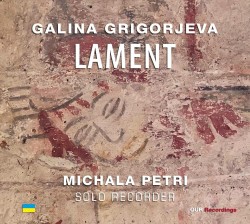 And this just in: As I was up against the deadline writing this column, I found in my inbox a very timely release from recorder virtuoso Michala Petri that I simply must share with you: Galina Grigorjeva – Lament (Our Recordings 9.70894 ourrecordings.com). I will let the press release speak for itself.
And this just in: As I was up against the deadline writing this column, I found in my inbox a very timely release from recorder virtuoso Michala Petri that I simply must share with you: Galina Grigorjeva – Lament (Our Recordings 9.70894 ourrecordings.com). I will let the press release speak for itself.
“As we all know the world has changed since February the 24th. What is going on with Putin’s atrocities against the free people of an independent nation is beyond our imagination. War is the antithesis of art and music and anathema to everything we represent and hold sacred – and it is difficult to find a way to respond to such a disaster. Everyone involved suffers on both sides – and the consequences affect the whole world – especially the most vulnerable. Since that tragic day Michala Petri has featured a very special work on all her concerts, Lament for recorder solo by the Ukrainian-born composer Galina Grigorjeva – and for the duration of this atrocity, she will continue to do so!
“Born in Crimea, Ukraine, Grigorjeva (b.1962) is one of the most original composers on the contemporary soundscape, creating timeless, ethereal music whose roots lay deep within Slavonic and Western sacred music traditions. Lament, for solo tenor recorder (2000), is a remarkable work, wonderfully engaging with a definite Slavic quality evoking the sounds of the Ukrainian overtone flute, the kalyuka. Beginning with an octave-and-a-half cry of anguish, wisps of melody become increasingly passionate and frantic [...] before retreating in resignation and acceptance.”
I encourage you to seek out this stunning work, and to support artistic contributions to Ukraine’s struggle wherever you encounter them. All involved in the recording worked for free; no expenses were incurred producing this moving digital release and all proceeds from the sale of Lament will be donated to the Kyiv Contemporary Music Days Foundation.
We invite submissions. CDs, DVDs and comments should be sent to: DISCoveries, WholeNote Media Inc., The Centre for Social Innovation, 503 – 720 Bathurst St. Toronto ON M5S 2R4.
David Olds, DISCoveries Editor
discoveries@thewholenote.com



